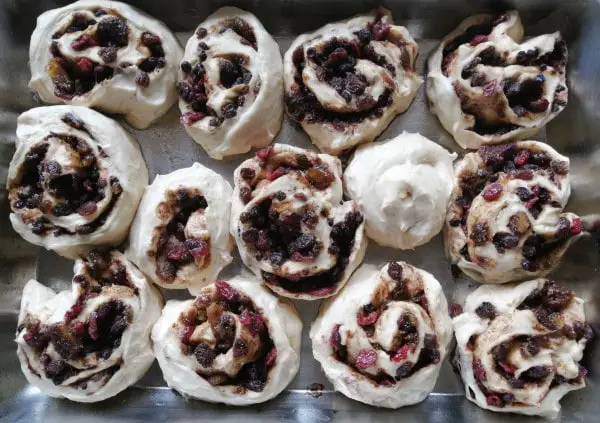
Cinnamon rolls, or Christmas rolls, as I have heard them described are simply magical all year round, but tweak them just a little to add some Christmas flavours – dried currants, raisins and cranberries – so often found at this time of the year and just a touch of a zingy lemon peel and you have a home run.
The first thing guests will notice when entering your house is the deceptively delicious aroma of hot cinnamon and sugar, with a lemon freshness that is guaranteed to make the mouth water. Turn into the kitchen and the mere sight of the rolls next to a steaming cup of tea will make your guests forget all their troubles – good times guaranteed in Yuletide, without the need to hop out into the cold to your nearest Cinnabon store. As the rolls rise, golden and fluffy, your heart will swell with pride, knowing that the deliciousness is all thanks to your homemade cinnamon rolls recipe. Each bite is a warm hug, wrapped in sweet memories and the joy of togetherness, leaving everyone at the table wanting seconds. With laughter filling the air and the comforting flavors surrounding you, the holiday spirit truly comes alive in your home.
This simple recipe will reward you with big, soft and fluffy cinnamon rolls, which can be prepared ahead of time or even be frozen. While the recipe calls for a sugar-lemon glaze, it is just as easy to substitute the glaze for a vanilla cream cheese glaze or any other type you desire.
What is the difference between a Chelsea Bun, a Cinnamon Roll and a Christmas Roll?
A cinnamon roll is made with a thicker glaze, which is added on after the roll has cooled as it usually includes cream cheese, whereas a Chelsea bun is made with a thinner glaze of icing sugar which is poured on while the buns are hot and therefore sinks into the bun, making it sticky and sweet.
Additionally, Chelsea buns traditionally include raisins while Cinnamon rolls include cinnamon.
Christmas rolls are the ultimate cross-over, with a thin glaze of apricot jam poured on while the rolls are fresh from the oven – making them sticky, while a glaze is added afterwards – giving extra flavour and both cinnamon and raisins are used. So, the basic flavours to the max!
And why not? After all, Yuletide is the time for good cheer, excesses and merriment.
How to ensure fluffy cinnamon rolls?
There are two basic tricks to ensuring that your cinnamon rolls are soft and fluffy – using bread flour and letting the sourdough starter do its trick nice and slowly.
How to ensure that the sourdough cinnamon rolls do not taste odd?
Sourdough that is allowed to ferment too fast can lead to an odd, typical sourdough taste. This is due to the various yeasts and bacteria at play in the starter. The culture you want does better at lower temperatures and the easiest way to achieve this is a long slow rise in the fridge. This does extend the process overnight, which is an added benefit as you can do all the “dirty” work the day before, finish up early in the morning and only have to bake in the afternoon, just before your guests arrive, if you can wait that long…
Can Croissants Be Transformed into Sourdough Cinnamon Rolls or Christmas Rolls?
Yes, croissants can absolutely be transformed into sourdough cinnamon rolls or Christmas rolls. By adding a sourdough starter to the dough, the result is a tangy and flavorful pastry that is a melt in your mouth perfection. Try it and experience the delicious transformation for yourself.
Tips for elevating a Chelsea bun to a Cinnamon roll and finally a proper Christmas roll:
Many bakers love to experiment and play around with ingredients. The list below will provide a rough overview of areas to explore and the expected results.
- Water vs. Milk: While the recipe uses water, most enriched dough recipes replace this with milk will add a sweeter, softer texture to the rolls. Use low fat or full cream milk if going this route, after all the purpose of the milk is to increase the fat content.
- Sugar: While sugar is mainly used to feed the yeast and get it to bloom faster, the choice of sugar influences the final product. Using demerara, brown or even treacle sugar will add a subtle depth of flavour. I prefer the treacle sugar for the molasses taste, which really pack a punch.
- Butter: There is simply no substitute, however adding more butter will slow down the fermentation process, thus the recipe will take longer to prepare. However, the trade-off is a more decadent, buttery, richer tasting roll which is preferred by all. Just do not substitute with margarine or butter “similar” products. These often have an undertone that detracts from the final product. I use salted butter because it is in my fridge – unsalted will be just as good, simply adjust the salt content correspondingly.
- Egg: Do not be scared of adding in an egg or two (one egg and 1 yolk is ideal). While the dough does sit on the countertop at room temperature for the first 2 hours, this will not affect you. The eggs add to the richness of the dough and play a big role in the texture.
- Bread flour: Baking makes use of the protein in the flour to help lighten the final product and improve the texture. During the bulk fermentation process, protein is converted to gluten, which allows for the rolls to have more structure and an even, open crumb. Using cake or all-purpose flour is not the same. European and US flours also tend to be higher in protein and will require more work to “activate” the gluten.
- Cinnamon: Cinnamon is not negotiable, but one should choose carefully and when possible use proper Ceylon cinnamon quills preferably, as quills retain the essential oils best, followed by cassia cinnamon quills, then if need be, Ceylon cinnamon powder and in last place, cassia cinnamon powder.
- Dried fruits: For year-round cinnamon rolls, sugar, cinnamon and cream cheem glaze are traditional. However, at Christmas time, add some decadence by incorporating dried fruits such as currants, raisins, sultanas, dried apricots, pears or apples and cranberries. Have a look at a typical Christmas tea or mulled wine (Glühwein) and play!
- Glaze or Icing: Plain sugar-lemon zest or cheese cream? The glaze is designed to soak in and make the rolls sticky – not ideal for genteel tea-parties, but perfect for a celebration! Cream cheese will add an interesting contrast to the basic roll and an additional level of richness.
How to prepare the rolls the day before:

Follow the recipe to the point where you have rolled them up, sliced them into discs and placed them into a pan. At this stage, simply cover them with plastic wrap (consider using a tall narrow cup to lift the center of the wrap) and place them in the fridge overnight (up to 18 hours should be fine). Allow to return to room temperature for 45 minutes or 1 hour before baking them.
How to freeze cinnamon rolls:
Freezing the rolls can take place at two points:
- Freeze before baking by freezing them just after they have been rolled up and cut into disks, just like the fridge option above. Place them into a pan and cover in plastic wrap and place in the freezer for up to 1 month. Once frozen, you can stack them neatly with some parchment paper between each roll and make a “sausage” out of the rolls. Just lay them out again in a pan prior to defrosting. Thaw out the rolls in the fridge to allow the thawing process to be even and then in on the counter for 45 minutes to an hour for the 2nd rise.
- Freeze after baking by cooling them to room temperature and then transferring them into an airtight container, either as a batch or individually. To defrost, set them in the fridge overnight or on the counter for a couple of hours and then warm them in an oven at 180C (350 F) for 10-15 minutes or just pop them in an air-fryer for 10 minutes at the same temperature. Alternatively, though not recommended, microwave them for 20-30 seconds. While the icing is freezer friendly, the best results are obtained when frosting the rolls after they have been reheated.
